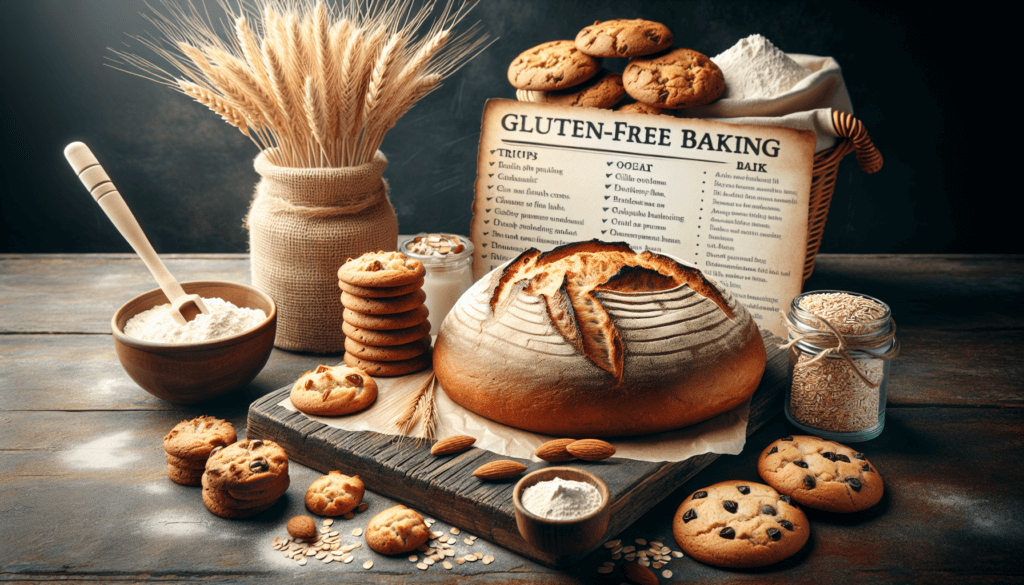Are you tired of missing out on all the delicious baked treats because you can’t have gluten? Well, worry no more! In this complete guide to baking with gluten-free flours, we’ll explore the wonderful world of gluten-free baking and show you how you can still indulge in all your favorite sweet and savory goodies. Whether you’re a seasoned baker or just starting out, we’ve got you covered with tips, tricks, and recipes that will make your gluten-free baking a breeze. Say goodbye to bland and dry baked goods and get ready to savor every moist and flavorful bite. So, grab your apron and let’s get baking!

Choosing the Right Gluten-Free Flour
Understanding different types of gluten-free flours
When it comes to gluten-free baking, understanding the different types of flours available is crucial. Each gluten-free flour has its own unique properties, flavors, and textures, which can greatly impact the outcome of your baked goods. Some common types of gluten-free flours include almond flour, coconut flour, rice flour, oat flour, quinoa flour, tapioca flour, and buckwheat flour.
Considering the flavor and texture of each flour
While all gluten-free flours are free from gluten, they can vary significantly in terms of taste and texture. Almond flour, for example, has a nutty flavor and can lend a moist, dense texture to your baked goods. On the other hand, coconut flour has a subtly sweet and slightly nutty flavor, and it can also add lightness and fluffiness to your recipes. Rice flour, oat flour, quinoa flour, tapioca flour, and buckwheat flour each have their own distinct flavors and textures as well.
Creating flour blends for optimal results
In order to achieve the best results in gluten-free baking, many bakers opt to create flour blends by combining different types of gluten-free flours. This allows them to strike a balance between different flavors and textures, and also helps to mimic the qualities of traditional wheat flour. Experimenting with different combinations of flours can help you discover the perfect blend for your specific recipe and preferences.
Understanding the Role of Gluten in Baking
Exploring the functions of gluten in traditional baking
Gluten is a protein found in wheat, rye, and barley that gives structure and elasticity to baked goods. It helps to trap air bubbles formed by leavening agents, allowing the dough to rise and creating a light and airy texture. Gluten also provides a chewiness and stretchiness to breads and pastries.
Identifying gluten substitutes in gluten-free flours
When baking without gluten, it’s important to identify substitutes that can perform similar functions. Many gluten-free flours contain substances such as xanthan gum or guar gum, which help to mimic the binding and elasticity properties of gluten. These gums can be used in conjunction with other gluten-free flours to create a texture that is similar to that of traditional wheat flour.

Tips for Successful Gluten-Free Baking
Using more liquids in gluten-free recipes
Gluten-free flours tend to absorb more liquid than traditional wheat flour, so it’s important to adjust the liquid content in your recipes accordingly. Adding more liquid can help to prevent your baked goods from becoming dry and crumbly. Experiment with increasing the amount of milk, water, or other liquids in your recipes until you achieve the desired consistency.
Incorporating binders and gum in gluten-free doughs
To help improve the texture and binding properties of gluten-free doughs, it can be helpful to incorporate binders such as eggs, applesauce, or yogurt. These ingredients can help to add moisture and structure to your baked goods. Additionally, using gums like xanthan gum or guar gum can help to improve the elasticity and stability of the dough.
Adjusting leavening agents for better rise
Since gluten-free flours lack the protein structure that allows for traditional rise, it’s important to adjust the amount of leavening agents in your recipes. Increasing the amount of baking powder or yeast can help to achieve a better rise in your baked goods. Be sure to follow the recommended guidelines for each specific type of flour, as they may require different proportions.
Adopting the spoon and level method for accurate measurements
Accurate measurements are crucial in gluten-free baking, as any slight variation can greatly affect the outcome of your recipe. To ensure accuracy, it is recommended to use the spoon and level method when measuring your flour. Simply spoon the flour into your measuring cup and level off the excess with a flat edge. This method helps to prevent compacting the flour, which can lead to too much flour in the recipe and result in dense or dry baked goods.
Almond Flour: A Versatile Gluten-Free Option
Nutritional benefits of almond flour
Almond flour, made from ground almonds, is not only a great gluten-free alternative but also offers a range of nutritional benefits. It is high in protein, fiber, healthy fats, and essential minerals such as magnesium and calcium. Incorporating almond flour into your baked goods can add a nutritional boost to your diet.
Using almond flour as a substitute in various recipes
Almond flour can be used as a 1:1 substitute for all-purpose flour in many recipes. Its slightly nutty flavor can enhance the taste of your baked goods, particularly in recipes like cakes, muffins, and cookies. However, due to its moisture-absorbing properties, it is important to use slightly less almond flour and add additional liquid to achieve the desired consistency.
Achieving optimal results with almond flour
To get the best results with almond flour, it is recommended to combine it with other gluten-free flours. Blending almond flour with tapioca flour or coconut flour can help to balance flavors and textures. Experimenting with different ratios and combinations will allow you to find the perfect balance for your specific recipe and personal taste preferences.

Coconut Flour: A Light and Fluffy Alternative
Understanding the unique properties of coconut flour
Coconut flour is made from dried coconut meat and is known for its incredible ability to absorb liquid. It has a sweet and subtle nutty flavor and adds a light and fluffy texture to baked goods. Due to its high fiber content, coconut flour is also filling and can be beneficial for digestion.
Adapting recipes when using coconut flour
When substituting coconut flour in recipes, it’s important to note that it is highly absorbent and requires more liquid compared to other flours. You will typically use less coconut flour and more eggs or other liquid ingredients to compensate for its absorption properties. It’s advisable to follow recipes specifically developed for coconut flour or research proper conversion ratios for best results.
Overcoming challenges of baking with coconut flour
Due to its absorbency, coconut flour can create dry and crumbly baked goods if not used correctly. To prevent this, it is important to add enough liquid and fat to the recipe. Additionally, coconut flour has a distinct flavor, so it’s important to consider whether the taste will complement your recipe. Experimenting with different blends and flavor combinations can help you achieve the desired results in your gluten-free baking endeavors.
Rice Flour: A Staple for Gluten-Free Baking
Differentiating between brown and white rice flour
Rice flour, made from finely milled rice grains, is a staple in gluten-free baking. There are two main types of rice flour: brown rice flour and white rice flour. Brown rice flour contains the bran layer, making it slightly darker in color and more nutritious. Meanwhile, white rice flour is made from polished rice and has a lighter texture and milder flavor.
Utilizing rice flour in breads, cookies, and cakes
Rice flour is a versatile gluten-free flour that can be used in a variety of recipes, including breads, cookies, and cakes. Its mild flavor allows it to seamlessly blend with other ingredients and flavors. However, due to its lack of gluten, it is important to add binders or gums to help improve the structure and texture of your baked goods.
Combining rice flour with other flours for better results
For optimal results, many bakers choose to combine rice flour with other gluten-free flours. Blending it with tapioca flour or potato starch can help to improve the texture and create a lighter crumb in your baked goods. Experimenting with different ratios and combinations will allow you to achieve the desired taste and texture for your specific recipes.

Oat Flour: A Nutritious and Affordable Option
Creating oat flour at home
Oat flour, made from ground oats, is a nutritious and budget-friendly gluten-free option. You can easily make oat flour at home by pulsing rolled oats in a blender or food processor until they reach a fine, flour-like consistency. Homemade oat flour offers the advantage of being free from cross-contamination with gluten, which can be a concern with store-bought options.
Baking with oat flour in various recipes
Oat flour has a mild and slightly sweet flavor, making it versatile for use in various recipes such as pancakes, muffins, and cookies. It provides a soft and moist texture to baked goods, while also adding a nutritional boost with its high fiber content. When substituting oat flour for all-purpose flour, it is generally recommended to use slightly less oat flour and add a bit more liquid.
Addressing concerns about gluten cross-contamination
While oats themselves do not naturally contain gluten, cross-contamination can occur during processing. It is crucial to choose certified gluten-free oats or oat flour if you have celiac disease or a gluten sensitivity. Reading labels and ensuring that the product is specifically labeled as gluten-free will help to eliminate any risks of cross-contamination.
Quinoa Flour: Adding Nutritional Value to Your Bakes
Exploring the health benefits of quinoa flour
Quinoa flour, made from ground quinoa seeds, is gaining popularity in gluten-free baking due to its nutritional value. Quinoa is a complete protein, containing all nine essential amino acids, making it a great choice for those following a plant-based diet. Quinoa flour is also high in fiber, iron, and other essential minerals.
Incorporating quinoa flour in breads and pastries
Quinoa flour adds a slightly nutty and earthy flavor to baked goods, making it a great choice for breads and pastries. However, it is important to note that quinoa flour can have a strong flavor, which may not be suitable for all recipes. To balance out the taste, it is recommended to combine quinoa flour with other milder gluten-free flours.
Overcoming the earthy taste of quinoa flour
If you find the earthy taste of quinoa flour overpowering, there are a few tricks you can try. Firstly, ensure that you are using a high-quality quinoa flour, as the taste can vary between brands. Secondly, balancing the flavor by combining quinoa flour with lighter and milder gluten-free flours, such as rice flour or tapioca flour, can help to tone down the earthiness. Lastly, incorporating flavors such as vanilla, cinnamon, or chocolate can mask the quinoa flavor and create a more enjoyable taste.

Tapioca Flour: Enhancing Texture and Chewiness
Understanding the role of tapioca flour in gluten-free baking
Tapioca flour, also known as tapioca starch, is derived from the cassava root and is a popular gluten-free alternative due to its unique properties. Tapioca flour adds moisture, chewiness, and flexibility to gluten-free baked goods. It also acts as a thickening agent, making it a valuable ingredient in sauces, gravies, and puddings.
Using tapioca flour in combination with other flours
Tapioca flour is often used in combination with other gluten-free flours to enhance the texture and binding properties of baked goods. When combined with almond flour, it can create a chewier texture in cookies and breads. Blending tapioca flour with rice flour or potato starch can also help to improve the overall structure and prevent baked goods from becoming too crumbly.
Improving the texture and chewiness of baked goods
If you’re looking to achieve a chewier texture in your gluten-free baked goods, tapioca flour can be a great addition. Experiment with different ratios and combinations to find the perfect balance for your desired texture. Tapioca flour can also help to improve the browning and crispiness of crusts, giving your baked goods a more professional and appealing appearance.
Buckwheat Flour: A Gluten-Free Grain Alternative
Differentiating between buckwheat flour and wheat flour
Despite its name, buckwheat is not actually a type of wheat but rather a grain-like seed. Buckwheat flour is a popular choice for those seeking gluten-free alternatives due to its distinct nutty flavor and nutritional benefits. It is high in fiber, protein, and essential minerals such as magnesium and manganese.
Experimenting with buckwheat flour in pancakes, muffins, and breads
Buckwheat flour adds a robust flavor to baked goods, making it ideal for pancakes, muffins, and breads. Its distinctive taste pairs well with ingredients like apples, cinnamon, or chocolate. However, it is important to note that buckwheat flour can result in denser and heavier baked goods. To counteract this, it can be blended with other lighter gluten-free flours or used in combination with a binder like xanthan gum.
Blending buckwheat flour with other flours for better taste and texture
To achieve a better taste and texture in your buckwheat flour-based recipes, consider blending it with other gluten-free flours. Combining buckwheat flour with rice flour, tapioca flour, or potato starch can help to balance out the flavors and create a lighter texture. Experimenting with different ratios and combinations will allow you to discover the perfect blend for your specific recipe and preferences.
In conclusion, choosing the right gluten-free flour is key to successful gluten-free baking. Understanding the properties, flavors, and textures of different gluten-free flours will help you create delicious and satisfying baked goods. Experimenting with flour blends, adjusting measurements, and incorporating additional binders and gums will further optimize your results. So go ahead, explore the world of gluten-free flours and let your baking adventures begin!


